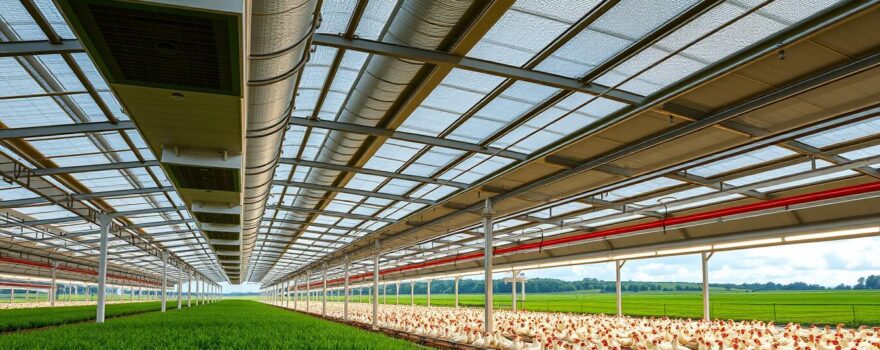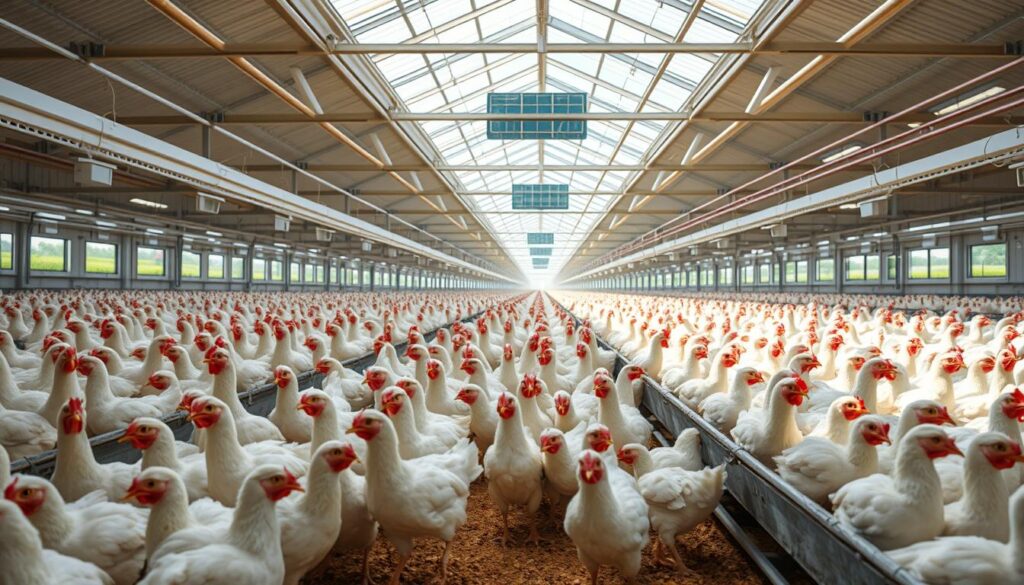
Broiler housing is key for keeping broiler chickens healthy and productive. Technology has changed how we design and manage broiler houses. This article looks at the latest tech used in broiler houses to ensure the best conditions for growth and welfare.
The poultry industry uses many technologies to keep the environment right for broiler chickens. These include climate control, ventilation, remote monitoring, and data analytics. By using these technologies, farmers can improve broiler performance, bird welfare, and operation efficiency.
Key Takeaways
- Modern broiler housing uses advanced technology to control and monitor the environment for optimal growth and welfare.
- Systems like Munters Trio provide accurate temperature control at every growth stage, reducing heat stress and improving feed conversion.
- Automated ventilation ensures consistent airflow and excellent air quality, managing humidity, carbon dioxide, and carbon monoxide levels.
- IoT sensors and smart controllers enable real-time adjustments and data-driven decisions for better flock outcomes.
- Energy-efficient solutions from Munters help farmers save costs and adopt sustainable practices.
Introduction to Broiler Housing Environmental Control
Broiler housing has changed a lot over time. This change is thanks to better broiler genetics and nutrition. Today, fast-growing broilers need the right environmental conditions to grow as much as they can. The inside of the broiler house is key to keeping the birds healthy and happy.
The Importance of Proper Environmental Conditions
Things like temperature, humidity, air quality, and lighting must be managed well. This is to help broiler performance and welfare. Keeping the environment right is vital for the birds’ health and growth.
Advances in Broiler Genetics and Nutrition
Thanks to broiler genetic selection and nutrition, raising a 5-pound broiler now takes just 6-7 weeks. This fast growth makes broiler housing environmental control even more important. The birds need their surroundings managed carefully because of their high metabolism.
| Statistic | Value |
|---|---|
| Time required to raise a 5-pound broiler | Reduced from over 12 weeks to 6-7 weeks |
| Broiler house dimensions | 40-50 ft wide, 400-600 ft long, 8 ft high sidewalls |
| Recommended insulation values | Ceiling: R-21, Walls: R-7 |
The changes in broiler genetics and nutrition have changed the poultry industry a lot. But, they’ve also made it more important to give the birds the best environmental conditions. This is to help their health, welfare, and how well they do their job.
Construction and Design of Modern Broiler Houses
Modern broiler houses are designed to support the growth and welfare of broilers. They have clear span structures with wood or steel trusses. This design creates an open space for cleaning and air flow.
Clear Span Structures and Insulation
Clear span structures make broiler house construction efficient and flexible. They remove interior support columns, maximizing space. This allows for better air circulation and easy movement of people and equipment.
Insulation in the ceiling and walls is key. It helps keep the temperature right and cuts down on heating and cooling costs.
Dropped Ceilings and Solid Side Walls
Dropped ceilings and solid side walls are important in modern broiler house design. They improve ventilation, heating, and light control. The dropped ceiling helps air flow evenly, while solid walls keep the temperature stable and prevent drafts.
“The design and construction of modern broiler houses are crucial in creating an optimal environment for broiler growth and welfare.”
Using clear span structures, insulation, dropped ceilings, and solid side walls helps control the environment. This leads to better broiler performance, health, and productivity.
Heating Systems for Broiler Houses
Keeping the right temperature is key for broiler health and growth. Broiler houses use different heating systems to keep the floor warm, between 85-90°F. These include radiant brooders, pancake brooders, forced air furnaces, and radiant tube heaters.
Maintaining Optimal Floor Temperatures
Good air flow, helped by circulation fans, spreads the warm air evenly. This keeps the broilers comfortable and healthy all over the house.
Fuel Sources and Heating Equipment
Propane and natural gas are the main fuels for heating broiler houses. They power the heating equipment, keeping the floor warm for the chickens.
| Fuel Source | Water Column Pressure |
|---|---|
| Propane | 10-12 inches |
| Natural Gas | 6-8 inches |
Keeping the heating systems in good shape is vital. It stops fuel waste and keeps the heat steady. Also, having the right sensors and ventilation is key for the best temperatures.
“Energy-efficient heating solutions play a crucial role in optimizing broiler farm performance in cold climates.”
Technology to Monitor and Control Environmental Conditions in Broiler Housing
Broiler houses use advanced tech to keep the environment just right for the birds. This is key as the seasons change. Farmers must adjust the housing to keep the temperature, humidity, and air quality perfect.
Ventilation Systems for Cold and Hot Weather
In cold weather, broiler houses use negative pressure ventilation. This system brings in fresh air and removes moisture and heat. It keeps the air inside the house comfortable and healthy, even when it’s cold.
When it’s hot, broiler houses use tunnel ventilation to blow away excess heat. This system works with evaporative cooling. It lowers the air temperature by up to 10°F, keeping the birds cool even on the hottest days.
Evaporative Cooling and Tunnel Ventilation
Evaporative cooling is vital in hot climates. It cools the air by passing it over wet pads. This cooler air is then spread throughout the house, making it comfortable for the birds. Tunnel ventilation helps remove heat, keeping the temperature just right.
These advanced systems let farmers control the environment in their houses. This ensures the birds grow well and stay healthy. By adjusting these systems, farmers can improve performance, save energy, and cut costs.
Controlling the House Environment with Electronic Controllers
Modern broiler houses use electronic controllers to keep the environment just right. These smart controllers watch over temperature and humidity levels. They adjust the heating, ventilation, and cooling to stay within set points.
This precise control makes sure the birds are comfortable and productive. It also helps save on energy costs.
Keeping the environment right is key for broiler health and performance. Bad ventilation can harm the birds, making them more prone to disease and affecting their growth. It’s important to have the right airflow to control temperature, humidity, and air quality.
Advanced digital sensors and controllers, like the MAXIMUS controller, help keep everything in check. They make adjustments as needed to keep the environment perfect.
The MAXIMUS controller manages everything in the broiler house. It watches over temperature, humidity, ventilation, and more. It’s a complete system for controlling the poultry operation.
With the MAXIMUS controller, producers can check on their houses from anywhere. They get updates and alerts in real-time. This means they can act fast to any issues.
The system also has features like remote access and automated adjustments. It even has fire prevention technology. This gives producers peace of mind and makes their work more efficient.
Alarm Systems and Backup Power
In broiler production, keeping the right environment in the poultry house is key. A short power or temperature problem can harm the birds’ health and performance. Modern broiler houses have advanced alarm systems and backup power to avoid these issues.
Alarms in broiler houses are vital for watching the inside environment. They alert farm managers if power is lost or if the temperature gets off track. This quick alert helps managers fix problems fast to keep the birds healthy.
To keep the environment stable, broiler houses have backup power like standby generators. These kick in when power goes out, keeping the vital systems running. This keeps the birds safe and the farm running smoothly.
| Statistic | Value |
|---|---|
| Typical power draw for a four-house broiler farm under full tunnel ventilation with evaporative cooling | 72-75 KW |
| Total starting wattage requirement for a four-house broiler farm | 239,400 watts |
| Recommended generator size for a four-house broiler farm | 105 KW |
Having broiler house alarms and backup power keeps the environment stable, even with power outages. This tech helps keep the birds safe and makes the farm more efficient and profitable.

Remote Monitoring and Control with IoT Sensors
The poultry industry has seen big changes with IoT technology. Broiler farmers can now check and control their houses from afar. This is thanks to IoT sensors that track things like temperature, humidity, and air quality.
Real-Time Data Analytics and Automation
IoT sensors send data to the cloud. Farmers can see this data on their phones or computers. This helps them adjust the house environment quickly to keep broilers healthy.
Automation also plays a big role. It lets the house systems change on their own. This means less work for farmers and better efficiency.
| IoT Sensor | Measured Parameter | Application |
|---|---|---|
| DOL 112-PT100 Temperature Sensor | Temperature | Monitoring and controlling house temperature for optimal broiler growth |
| DOL 119 CO2 Sensor | Carbon Dioxide (CO2) Levels | Maintaining air quality and ventilation for broiler welfare |
| DOL 53 Ammonia Sensor | Ammonia (NH3) Levels | Monitoring and regulating ammonia levels to prevent respiratory issues in broilers |
| DOL 114 Humidity and Temperature Sensor | Humidity and Temperature | Optimizing environmental conditions for broiler comfort and performance |
IoT sensors have changed how farmers work. They give real-time data and make adjustments automatically. This helps farmers improve their work, care for animals better, and be more sustainable.
Benefits of Environmental Control Technology
Advanced environmental control technology in broiler houses brings many benefits. It keeps the temperature, humidity, air quality, and lighting just right. This helps the birds stay healthy and comfortable, leading to improved broiler welfare and performance.
Modern broiler houses are also built to save energy. They use smart systems to control heating, cooling, and ventilation. This cuts down on costs and reduces the environmental impact of raising broilers, leading to improved energy efficiency and cost savings.
Improved Bird Welfare and Performance
Keeping the broiler house environment just right is key for the birds’ health and growth. By controlling temperature and humidity, farmers ensure the birds are comfortable. This boosts broiler welfare and leads to better growth, feed conversion, and productivity.
Energy Efficiency and Cost Savings
Advanced environmental control technology makes broiler houses more energy-efficient and cost-effective. Modern facilities are designed to use less energy. Smart systems help farmers manage heating, cooling, and ventilation better, saving on energy and expenses.
“Precision farming and data-driven decisions have revolutionized the poultry industry, enabling farmers to optimize production.”
Remote monitoring and automated control systems make things even better. They provide real-time data and allow for remote adjustments. This boosts cost savings and makes broiler production more environmentally sustainable.

Broiler housing has changed a lot, thanks to new technology. This tech helps keep the environment just right for broiler chickens. Modern broiler houses are designed with the latest tech to be comfy, energy-saving, and productive.
Broiler farmers use cutting-edge tech like precision farming and automation. This helps their chickens grow better and their farms run smoother. Digital sensors and climate control systems keep the chickens healthy and happy, leading to better growth and more food.
The need for food is growing, making sustainable broiler housing key. By using new tech, the poultry industry can meet this demand. It can also focus on animal welfare and protecting the environment. The future of broiler farming is bright, with tech and good management working together.